Ti-Al相图(工程材料科学与设计)
- 格式:ppt
- 大小:2.47 MB
- 文档页数:25
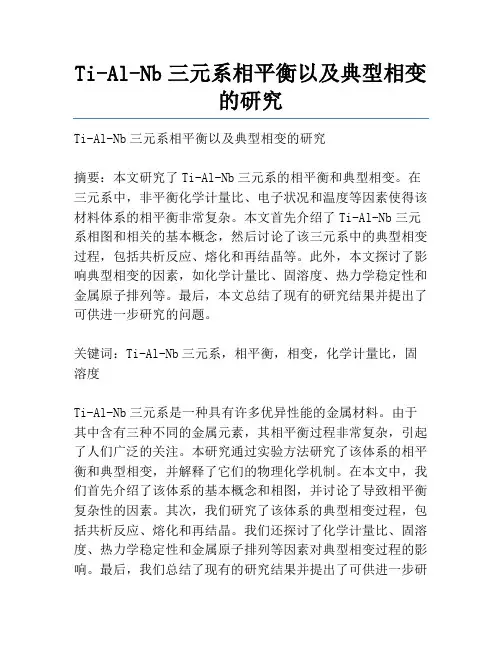
Ti-Al-Nb三元系相平衡以及典型相变的研究Ti-Al-Nb三元系相平衡以及典型相变的研究摘要:本文研究了Ti-Al-Nb三元系的相平衡和典型相变。
在三元系中,非平衡化学计量比、电子状况和温度等因素使得该材料体系的相平衡非常复杂。
本文首先介绍了Ti-Al-Nb三元系相图和相关的基本概念,然后讨论了该三元系中的典型相变过程,包括共析反应、熔化和再结晶等。
此外,本文探讨了影响典型相变的因素,如化学计量比、固溶度、热力学稳定性和金属原子排列等。
最后,本文总结了现有的研究结果并提出了可供进一步研究的问题。
关键词:Ti-Al-Nb三元系,相平衡,相变,化学计量比,固溶度Ti-Al-Nb三元系是一种具有许多优异性能的金属材料。
由于其中含有三种不同的金属元素,其相平衡过程非常复杂,引起了人们广泛的关注。
本研究通过实验方法研究了该体系的相平衡和典型相变,并解释了它们的物理化学机制。
在本文中,我们首先介绍了该体系的基本概念和相图,并讨论了导致相平衡复杂性的因素。
其次,我们研究了该体系的典型相变过程,包括共析反应、熔化和再结晶。
我们还探讨了化学计量比、固溶度、热力学稳定性和金属原子排列等因素对典型相变过程的影响。
最后,我们总结了现有的研究结果并提出了可供进一步研究的问题。
在Ti-Al-Nb三元系中,非平衡化学计量比是相平衡的一个重要因素。
当存在非平衡化学计量比时,可能会形成多个涉及多种元素的相。
这些相通常通过在不同化学计量比的条件下加热和冷却来形成。
此外,在该体系中,固溶度和金属原子排列也会影响相平衡。
本文的实验结果证明了在Ti-Al-Nb三元系中,非平衡化学计量比和金属原子排列对相平衡有重要影响,而固溶度对相平衡的影响并不显着。
在典型相变方面,共析反应是Ti-Al-Nb三元系中最常见的相变之一。
在共析反应中,Ti3Al和NbAl3两相通过与Al形成Al3Ti和Al3Nb两相,形成了新的相组成。
通过实验,我们发现,固定Ti-Al-Nb三元系的化学计量比后,共析反应的温度与Ti/Al的比例相关性非常显著。

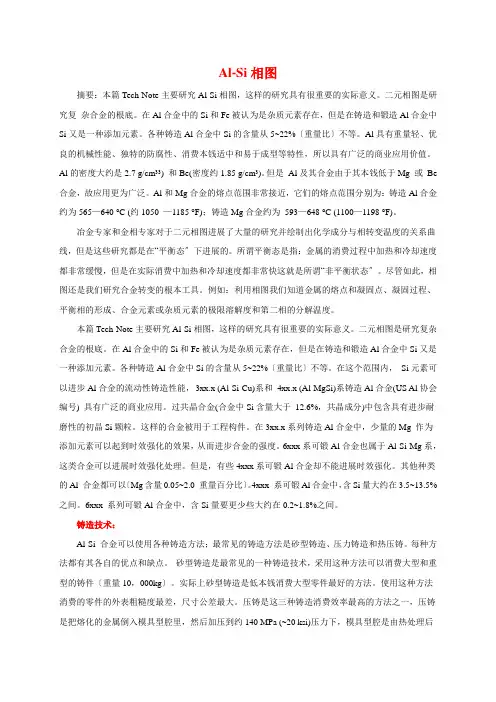
Al-Si相图摘要:本篇Tech-Note主要研究Al-Si相图,这样的研究具有很重要的实际意义。
二元相图是研究复杂合金的根底。
在Al合金中的Si和Fe被认为是杂质元素存在,但是在铸造和锻造Al合金中Si又是一种添加元素。
各种铸造Al合金中Si的含量从5~22%〔重量比〕不等。
Al具有重量轻、优良的机械性能、独特的防腐性、消费本钱适中和易于成型等特性,所以具有广泛的商业应用价值。
Al的密度大约是2.7 g/cm33) 和Be(密度约1.85 g/cm3)。
但是Al及其合金由于其本钱低于Mg 或Be 合金,故应用更为广泛。
Al和Mg合金的熔点范围非常接近,它们的熔点范围分别为:铸造Al合金约为565—640 °C (约1050 —1185 °F);铸造Mg合金约为593—648 °C (1100—1198 °F)。
冶金专家和金相专家对于二元相图进展了大量的研究并绘制出化学成分与相转变温度的关系曲线,但是这些研究都是在“平衡态〞下进展的。
所谓平衡态是指:金属的消费过程中加热和冷却速度都非常缓慢,但是在实际消费中加热和冷却速度都非常快这就是所谓“非平衡状态〞。
尽管如此,相图还是我们研究合金转变的根本工具。
例如:利用相图我们知道金属的熔点和凝固点、凝固过程、平衡相的形成、合金元素或杂质元素的极限溶解度和第二相的分解温度。
本篇Tech-Note主要研究Al-Si相图,这样的研究具有很重要的实际意义。
二元相图是研究复杂合金的根底。
在Al合金中的Si和Fe被认为是杂质元素存在,但是在铸造和锻造Al合金中Si又是一种添加元素。
各种铸造Al合金中Si的含量从5~22%〔重量比〕不等。
在这个范围内,Si元素可以进步Al合金的流动性铸造性能,3xx.x (Al-Si-Cu)系和4xx.x (Al-MgSi)系铸造Al合金(US Al协会编号) 具有广泛的商业应用。
过共晶合金(合金中Si含量大于12.6%,共晶成分)中包含具有进步耐磨性的初晶Si颗粒。
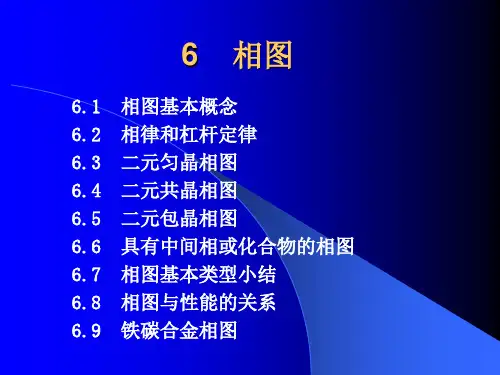

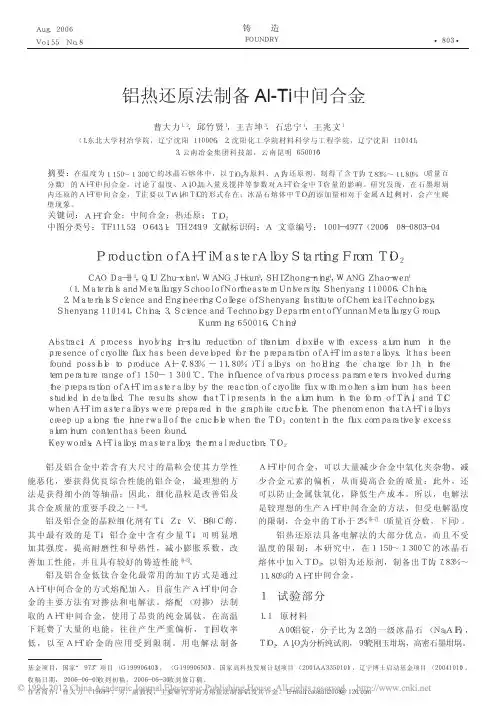
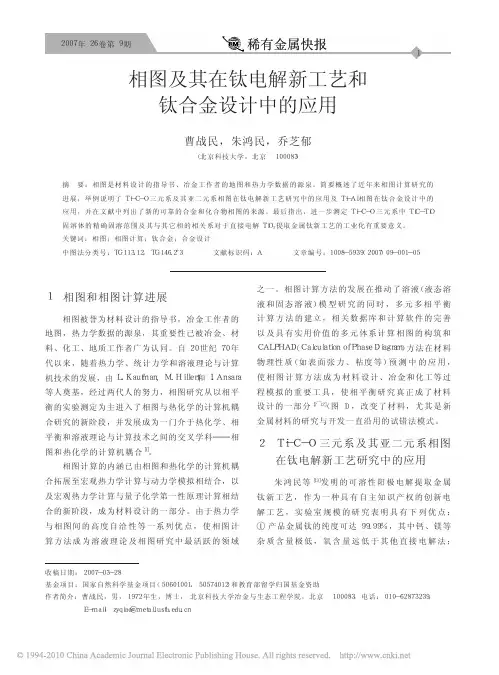
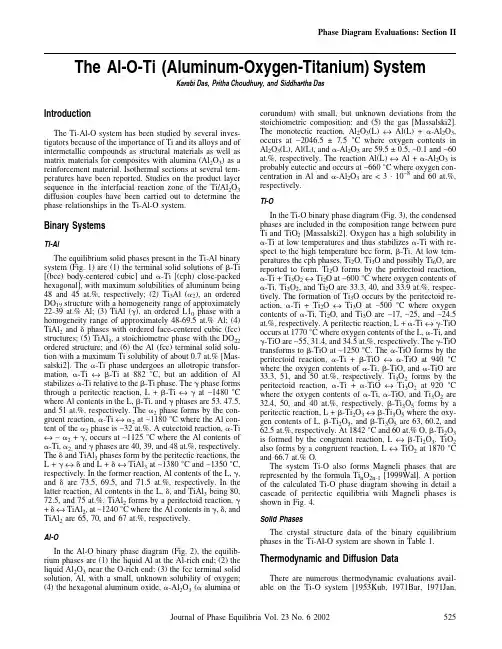
The Al-O-Ti(Aluminum-Oxygen-Titanium)SystemKarabi Das,Pritha Choudhury,and Siddhartha DasIntroductionThe Ti-Al-O system has been studied by several inves-tigators because of the importance of Ti and its alloys and ofintermetallic compounds as structural materials as well asmatrix materials for composites with alumina(Al2O3)as areinforcement material.Isothermal sections at several tem-peratures have been reported.Studies on the product layersequence in the interfacial reaction zone of the Ti/Al2O3diffusion couples have been carried out to determine thephase relationships in the Ti-Al-O system.Binary SystemsTi-AlThe equilibrium solid phases present in the Ti-Al binarysystem(Fig.1)are(1)the terminal solid solutions of-Ti[(bcc)body-centered cubic]and␣-Ti[(cph)close-packedhexagonal],with maximum solubilities of aluminum being48and45at.%,respectively;(2)Ti3Al(␣2),an orderedDO19structure with a homogeneity range of approximately22-39at.%Al;(3)TiAl(␥),an ordered L10phase with ahomogeneity range of approximately48-69.5at.%Al;(4)TiAl2and␦phases with ordered face-centered cubic(fcc)structures;(5)TiAl3,a stoichiometric phase with the DO22ordered structure;and(6)the Al(fcc)terminal solid solu-tion with a maximum Ti solubility of about0.7at.%[Mas-salski2].The␣-Ti phase undergoes an allotropic transfor-mation,␣-Ti↔-Ti at882°C,but an addition of Alstabilizes␣-Ti relative to the-Ti phase.The␥phase formsthrough a peritectic reaction,L+-Ti↔␥at∼1480°Cwhere Al contents in the L,-Ti,and␥phases are53,47.5,and51at.%,respectively.The␣2phase forms by the con-gruent reaction,␣-Ti↔␣2at∼1180°C where the Al con-tent of the␣2phase is∼32at.%.A eutectoid reaction,␣-Ti ↔∼␣2+␥,occurs at∼1125°C where the Al contents of ␣-Ti,␣2,and␥phases are40,39,and48at.%,respectively. The␦and TiAl3phases form by the peritectic reactions,theL+␥↔␦and L+␦↔TiAl3at∼1380°C and∼1350°C,respectively.In the former reaction,Al contents of the L,␥,and␦are73.5,69.5,and71.5at.%,respectively.In thelatter reaction,Al contents in the L,␦,and TiAl3being80,72.5,and75at.%.TiAl2forms by a peritectoid reaction,␥+␦↔TiAl2,at∼1240°C where the Al contents in␥,␦,andTiAl2are65,70,and67at.%,respectively.Al-OIn the Al-O binary phase diagram(Fig.2),the equilib-rium phases are(1)the liquid Al at the Al-rich end;(2)theliquid Al2O3near the O-rich end;(3)the fcc terminal solidsolution,Al,with a small,unknown solubility of oxygen;(4)the hexagonal aluminum oxide,␣-Al2O3(␣alumina or corundum)with small,but unknown deviations from the stoichiometric composition;and(5)the gas[Massalski2]. The monotectic reaction,Al2O3(L)↔Al(L)+␣-Al2O3, occurs at∼2046.5±7.5°C where oxygen contents in Al2O3(L),Al(L),and␣-Al2O3are59.5±0.5,∼0.1and∼60 at.%,respectively.The reaction Al(L)↔Al+␣-Al2O3is probably eutectic and occurs at∼660°C where oxygen con-centration in Al and␣-Al2O3are<3·10−8and60at.%, respectively.Ti-OIn the Ti-O binary phase diagram(Fig.3),the condensed phases are included in the composition range between pure Ti and TiO2[Massalski2].Oxygen has a high solubility in ␣-Ti at low temperatures and thus stabilizes␣-Ti with re-spect to the high temperature bcc form,-Ti.At low tem-peratures the cph phases,Ti2O,Ti3O and possibly Ti6O,are reported to form.Ti2O forms by the peritectoid reaction,␣-Ti+Ti3O2↔Ti2O at∼600°C where oxygen contents of ␣-Ti,Ti3O2,and Ti2O are33.3,40,and33.9at.%,respec-tively.The formation of Ti3O occurs by the peritectoid re-action,␣-Ti+Ti2O↔Ti3O at∼500°C where oxygen contents of␣-Ti,Ti2O,and Ti3O are∼17,∼25,and∼24.5 at.%,respectively.A peritectic reaction,L+␣-Ti↔␥-TiO occurs at1770°C where oxygen contents of the L,␣-Ti,and ␥-TiO are∼55,31.4,and34.5at.%,respectively.The␥-TiO transforms to-TiO at∼1250°C.The␣-TiO forms by the peritectoid reaction,␣-Ti+-TiO↔␣-TiO at940°C where the oxygen contents of␣-Ti,-TiO,and␣-TiO are 33.3,51,and50at.%,respectively.Ti3O2forms by the peritectoid reaction,␣-Ti+␣-TiO↔Ti3O2at920°C where the oxygen contents of␣-Ti,␣-TiO,and Ti3O2are 32.4,50,and40at.%,respectively.-Ti3O5forms by a peritectic reaction,L+-Ti2O3↔-Ti3O5where the oxy-gen contents of L,-Ti2O3,and-Ti3O5are63,60.2,and 62.5at.%,respectively.At1842°C and60at.%O,-Ti2O3 is formed by the congruent reaction,L↔-Ti2O3.TiO2 also forms by a congruent reaction,L↔TiO2at1870°C and66.7at.%O.The system Ti-O also forms Magneli phases that are represented by the formula Ti n O2n-1[1999Wal].A portion of the calculated Ti-O phase diagram showing in detail a cascade of peritectic equilibria with Magneli phases is shown in Fig.4.Solid PhasesThe crystal structure data of the binary equilibrium phases in the Ti-Al-O system are shown in Table1. Thermodynamic and Diffusion DataThere are numerous thermodynamic evaluations avail-able on the Ti-O system[1953Kub,1971Bar,1971Jan,Fig.1Ti-Al binary phase diagram[Massalski2]Fig.2Al-O binary phase diagram[Massalski2]1973Bar,1975Cha,1982Pan,1994Lee,1997Fis]as well as on the Ti-Al system [1955Kub,1971Bar,1979Dew,1983Lia,1988Gro,1988Mur].The free energies of forma-tion of the relevant phases in the Ti-Al-O system as given by [1990Cho]and [1992Li]are presented in Table 2.The free energies of formation given by Cho et al.[1990Cho]and Li et al.[1992Li]that are compiled from different sources as well as calculated by the authors [1992Li]areFig.3Ti-O binary phase diagram[Massalski2]Fig.4Ti-O binary phase diagram showing in detail a cascade of peritectic equilibria [1999Wal]quite useful in calculating the isothermal section at 1100°C.This isothermal section agrees very well with the experi-mental one,excluding the Ti-rich corner where ␣-Ti(Al,O)and -Ti(Al,O)solid solutions were not taken into account.The relevant diffusion data of this ternary system are shown in Table 3.Isothermal Sections and Phase EquilibriaAt 1100°CNumerous researchers [1989Kiv,1990Cho,1991Sel,1992Zha,1992Li,1997Lee]have studied the phase equilib-ria in the Ti-Al-O system at 1100°C.[1991Sel]have also studied the interface reactions between titanium and alu-mina up to 1250°C,but have not reported any isothermal section.However,different versions of the isothermal sec-tion at 1100°C have been proposed by [1989Kiv]and [1992Li].[1989Kiv]have used Ti/Al 2O 3diffusion couples an-nealed at 1100°C for various lengths of time (1-64h)fol-lowed by rapid cooling.High purity (>99.99%)and com-mercial purity titanium and pure sapphire single crystal (>99.7%)have been used in this position analy-sis has been carried out by the WDS technique in a scanning electron microscope (SEM).With the help of the Thermo-Calc Program [1985Sun],the available thermodynamic data have been optimized and the partial phase diagram at 1100°C (Fig.5)has been proposed by [1989Kiv].The combined solubility of aluminum and oxygen in -Ti at 1100°C is calculated,and the results proposed are shown in Fig.6[1989Kiv].In this study the existence of ␣/phase bound-ary at the Ti/Al 2O 3junction at 1100°C is established.The -Ti possibly reduces Al 2O 3at 1100°C,and dissolves both oxygen and aluminum according to the reaction:Al 2O 3→2[Al]Ti +3[O]Ti .Owing to higher diffusivity (Table 3),oxygen first saturates the -Ti.This leads to the generation of the ␣-phase between the Al 2O 3and the phase.Experi-mentally,about 5at.%difference in oxygen contents be-tween the ␣and phases is measured across the phase boundary.The ␣-phase,which is more stable than the phase,is found to be in equilibrium with the Al 2O 3phase.Hence,with increasing stability,i.e.,decreasing free energy of the system,the ␣/phase boundary moves into the -Ti phase.Electron probe microanalysis (EPMA)reveals the presence of Ti 3Al and possibly TiAl phases,but there is no indication of the presence of TiO phase or the dissolution of Ti in the Al 2O 3phase.In this study,the experimental find-ings and the thermodynamic analysis of the Ti-rich part of the Ti/Al 2O 3system have been well correlated.Selverian and colleagues [1991Sel]have studied the in-terface reactions of Ti with (112)plane of sapphire from room temperature to 1250°C.Titanium has been deposited on the cleaned surface of sapphire by the resistive heating of a Ti ribbon.The x-ray photoelectron spectroscopy (XPS),transmission electron microscopy (TEM),x-ray diffraction (XRD),and Rutherford backscattering spectroscopy (RBS)have been used in this investigation to study the interface from the monolayer regimen up to the bulk regimen.The reaction products identified at the interface are a layer of Ti 3Al(O)adjacent to the sapphire and a Ti 0.67(O)0.33layer at the free surface.The net reaction between Ti and sapphire is suggested as 8Ti +Al 2O 3ס3Ti 0.67(O)0.33+2Ti 3Al(O).As a result of this reaction,Ti-O bonds form across the inter-face.A mixed bonding between Ti,Al,and O constitutes a small percentage of the interface bonding.The near-surface oxygen atoms in the sapphire are major constituents of the chemical bonds with Ti.In this study,it has been found that the Ti-Al 2O 3reaction is thermodynamically favorable at all temperatures.Results obtained by Choi et al.,Li et al.,and Zhang et al.[1990Cho,1992Li,1992Zha,]are essentially the same and are shown in the isothermal section of Fig.7.Both the papers,[1990Cho,1992Li],are published by the same re-Table 1Crystallographic Data of the BinaryEquilibrium Phases in the Ti-Al-O System [Pearson3]Composition Pearson’s Symbol Space Group Prototype Lattice Parameters,nma b c ␣-Ti(O,Al)hP 2P 63/mmc Mg 0.29508…0.46855-Ti cI 2Im 3m W 0.33065……TiAl tP 4P 4/mmm AuCu 0.4005…0.4070TiAl 2tI 24I 41/amd Ga 2Hf 0.3976… 2.4360TiAl 3tI 8I 4/mmm Al 3Ti 0.3848…0.8596Ti 3Al hP 8P 63/mmc Ni 3Sn 0.5782…0.4629TiO cF 8Fm 3m NaCl 0.4180……Ti 2O hP 3P 3m1CdI 20.296…0.483Ti 3O hP 16P 31c Ti 3O 0.515…0.956Ti 2O 3hR 10R 3c Al 2O 30.51580… 1.3611Ti 3O 2hP 6P 6/mmm …0.4991…0.2879TiO 2tP 6P 42/mnm TiO 20.45937…0.29619Al cF 4Fm 3m Cu 0.40488……Al 2O 3hR 10R 3cAl 2O 30.4754…1.299Table 2Free Energies of Formation,⌬G 0of Relevant Phases in the Ti-Al-O System [1990Cho,1992Li]Compounds⌬G 0,at 1000°CJ/g atom ⌬G 0,at 1100°CJ/mol 1/3Ti 2O −146502.0…1⁄2␣-TiO −210701.0…1/2-TiO −210961.0−205907.01/5Ti 2O 3−234463.0−229223.01/8Ti 3O 5−234357.0−232032.01/3TiO 2−238276.0−231994.0␣-Ti(O)[Ti 0.915O 0.085]−44272␣-Ti(O)[Ti 0.67O 0.33]−1520001/11Ti 4O 7…−2316641/4Ti 3Al −17257.5−18377.01/2TiAl −27179.2−26165.01/3TiAl 2−27666.0−26000.01/4TiAl 3−18687.8−23007.01/5Al 2O 3−254273.0…Ti 0.668Al 0.222O 0.11…−68272.0Ti 0.485Al 0.485O 0.03…−39837.0search group;therefore,their later phase diagram [1992Li]is reported here (Fig.7).Li et al.[1992Li]have prepared diffusion couples by applying Ti-based coatings on sintered alumina (99.7wt.%)or single-crystal sapphire as well as by hot pressing Ti (99.8wt.%)and alumina slices (99.9wt.%).Homogeneous alloys have been prepared both by powder metallurgy as well as arc-melting routes.The alloys made by powder metallurgy route have been subsequently an-nealed at 800and 1000°C until equilibrium has been at-tained.The arc-melted samples are homogenized at 1100°C.The starting materials for preparing the homogeneous samples are titanium lumps and alloys having compositions Ti 2O 3,Ti 3Al,or TiAl.Analyses of the alloys and diffusion couples are done by microscopy (both optical and SEM),EPMA,and XRD.One important part of this study [1992Li]is the care exercised in the oxygen analysis.Quantitative analysis of oxygen by EPMA is not very accurate due to the presence of a thin oxide film on the surface of the alloy.This oxide film is responsible for the high apparent oxygen content.The authors [1992Li]claim that they are able to study the actual bulk oxygen concentration as well as the thickness and composition of the surface films by doing EPMA measurements at various excitation voltages starting from 2-20kV with a beam current of 10nA and using the computer program PROZA and the thin-film programs of Bastin and colleagues [1986Bas,1990Bas].For the diffu-sion couples with a thin layer of Ti,the reaction product layer sequence is found to be as Al 2O 3/␣2-Ti 3Al/Ti 2O,where Ti 2O represents ␣-Ti saturated by the oxygen disso-lution and containing a maximum of ∼5at.%Al.With a thick layer of Ti,the layer sequence is Al 2O 3/␥-TiAl(O)/␣2-Ti 3Al(O)/␣-Ti(O,Al)/-Ti.Results from both diffusion couple study as well as equilibrated samples have been used to develop the isothermal section of Fig.7.Thermodynamic calculations were also used to verify the isothermal section obtained by experimental means.Thermodynamic calcula-tions based on purely binary systems predict the tie-lines between TiAl and the saturated ␣-Ti(O)or -Ti(O)solid solution instead of the experimentally observed tie-lines be-tween Al 2O 3and Ti 3Al.However,when Li et al.[1992Li]considered the solubility of oxygen in Ti 3Al and TiAl,the calculated tie-lines match with the experimental ones.Zhang et al.[1992Zha]also studied the Ti-Al-O system at 1100°C using Ti (99.9%),TiO (99.9%),TiAl 3(99.5%),and Al 2O 3(99.99%)for the preparation of the homogeneous bulk samples.These samples were annealed at 1000and 1100°C until equilibrium was attained;this was followed by water quenching.Diffusion couples have been prepared with 99.7%Ti (foil and sheet)and single-crystal sapphire.The diffusion couples were also annealed at 1100°C and then analyzed to detect the phases.The diffusion layer se-quence,detected by Zhang et al.[1992Zha],is the same asTable 3Relevant Diffusion Data for Ti-Al-O System [1971Tre]D at 538.0°CD at 815.5°C Reaction Rate Constant at 538.0°C O 2in Ti 4.0и10−16cm 2/s 2.0и10−11cm 2/s …Al in Ti6.7и10−14cm 2/s3.0и10−10cm 2/s…Pure Ti/Al 2O 3…… 2.5и10−8cm/s 1/2Ti-6Al-4V/Al 2O 3……5.0и10−8cm/s 1/2Fig.5Assessedpartial phase diagram of Ti-Al-O system at 1100°C [1989Kiv]Fig.6Combined solubility of Al and O in -Ti at 1100°C [1989Kiv]that of Choi et al.and Li et al.[1990Cho,1992Li]as stated earlier.The isothermal section at 1100°C,proposed by Zhang [1992Zha],is essentially the same as that of Li [1992Li]as shown in Fig.7.Lee and Saunders [1997Lee]have calculated the isother-mal section at 1100°C (Fig.8).The phase relations in the calculated isothermal section are in accordance with those reported recently by Li et al.[1992Li]and Zhang et al.[1992Zha].The authors have also shown that Ti 2O 3and Al 2O 3form a solid solution at 1100°C,though the solu-bilities of Ti in Al 2O 3in equilibrium with ␣-Ti,Ti 3Al and TiAl are small.The solubility limits of oxygen at 1100°C in Ti 3Al and TiAl have been reported to be 13and 3at.%,respectively.At 945°CKelkar and Carim [1995Kel]have used Ti,TiO 2,and Al powders of >99.9%purity to prepare strong pellets.The pellets have subsequently been arc-melted,annealed at 945°C for 15days in evacuated quartz tubes,and air-cooled.Phase compositions of the samples are analyzed by EPMA.The isothermal section,assessed in this study,is shown in Fig.9].The two-phase boundaries in this figure have been obtained from the evaluations of the Ti-O,Ti-Al,Al-O sys-tems by [1987Mur],[1992Kat],and [1985Wri],respec-tively.In this diagram,the single-phase regions are shaded,while Roman numerals indicate the three phase regions of interest.In region I,Ti 3O 2,Al 2O 3,and Ti 2O are in equilib-rium,as are ␣-Ti(O,Al),Ti 3Al(O),and Al 2O 3in region II,and TiAl(O),Ti 3Al(O)and Al 2O 3in region III.Unlike ear-lier phase diagrams,here TiO is distinguished into ␣-TiO and -TiO forms.The sizes of the ␣-Ti(O,Al)and Ti 3Al(O)single-phase regions are different from those reported in the earlier diagrams.Ti 3O 2is an additional phase shown in this diagram.In this study,phase composition measurements aremade close to the three-phase junctions,but far enough (>5m)so that they would not be affected by signals from the neighboring phases.Hence,the estimation of the phase boundaries by this method is expected to be of greater ac-curacy than those obtained by using the diffusion ing the phase relations in Fig.9and the thermodynamic data generated in this study,the chemical stability of the following layer sequences in the Ti/Al 2O 3diffusion couple has been confirmed.Al 2O 3/Ti 3Al[O]/Ti 2O [1991Sel]Al 2O 3/Ti 3Al[O][1991Sel]Al 2O 3/TiAl[O]/Ti 3Al[O]/␣-Ti[O,Al]/-Ti[1992Li,1992Zha]Fig.7Experimentally determined isothermal section of the Ti-Al-O system at 1100°C with diffusion paths indicated[1992Li]Fig.8The calculated isothermal section of the Ti-Al-O ternary system at 1100°C[1997Lee]Fig.9Isothermal section of Ti-Al-O system at 945°C [1995Kel]The sequence Al 2O 3/TiO/Ti 3Al[O]/␣-Ti,reported by [1973Tre],is found to be inconsistent with the data of Kelkar and Carim [1995Kel].If TiO is to be one of the equilibrium phases with Al 2O 3at one end and Ti 3Al[O]/␣-Ti at the other,then the reaction sequence should be Al 2O 3/TiO/Ti 3O 2/Ti 2O/Ti 3Al[O]/␣-Ti [1995Kel].However,Ti 3O 2and Ti 2O are not present at the interface.Hence,it is prob-able that the TiO phase has been wrongly identified and is actually TiAl,suggesting the layer sequence to be that re-ported by Li et al.and Zhang et al.[1992Li,1992Zha].The incorrect identification could have been due to the close proximity of the lattice parameters of the TiO and TiAl phases,0.418and 0.4nm,respectively.At 900°CA simplified 900°C isothermal section of Ti-Al-O sys-tem is shown in Fig.10[1991Rah].Intermetallic com-pounds like Ti 3Al,TiAl,and TiAl 3are considered in this estimated diagram as line compounds and this is the inher-ent limitation of this diagram.At 871°CThe earliest evaluation of the Ti-Al-O system has been made by Tressler et al.[1973Tre]at 871°C.To study thecompatibility between the phases,mixtures of Ti,Al,and TiO 2powders are compacted and annealed at 871°C for various lengths of time,followed by water quenching.The diffusion couples are prepared with c-axis sapphire fila-ments diffusion bonded between polished and etched Ti alloy foils under vacuum.One of the samples consists of a large single crystal of alumina to provide sufficient quanti-ties of reaction product for the XRD analysis.The sample is annealed at 981°C for 940h.Two possible isothermal sections at 871°C have been proposed,as shown in Fig.11(a)and (b).Both are almost identical.The difference between the two is in the existence of the equilibrium be-tween TiAl,TiO,and Ti 2O 3(Fig.11a),and between Ti 3Al,TiO and Ti 2O 3(Fig.11b).The reaction product layerse-Fig.10An estimated isothermal section of the Ti-Al-O ternary system at 900°C[1991Rah]Fig.11(a)First of the two possible isothermal sections of the Ti-Al-O system at 871°C[1973Tre]Fig.11(b)Second of the two possible isothermal sections of the Ti-Al-O system at 871°C [1973Tre]quence at the Ti/Al 2O 3junction is found to be Al 2O 3/TiO/Ti 3Al/␣-Ti.Except TiO,all other phases are detected by the XRD analysis.The TiO phase is detected by the reflection electron diffraction technique.However,none of the pro-posed phase diagrams indicate the existence of an equilib-rium between the Al 2O 3and TiO phases.It is most likely that the TiO phase is not identified correctly and is actually TiAl,as suggested by the later investigators [1990Cho,1992Li,1992Zha].According to the latter,the requirementsof the local phase equilibrium are not satisfied by the se-quence Al 2O 3/TiO/Ti 3Al/␣-Ti.In this layer sequence,Al has to diffuse from a higher activity in Al 2O 3to a minimum activity in TiO and again to a higher activity in Ti 3Al,which is thermodynamically not possible.This is also shown in Fig.12(a)and (b).At 800°CThe estimated 800°C Ti-Al-O isothermal section is shown in Fig.13[1991Lut].Authors [1991Lut]have men-tioned that they did not consider phases like Ti 3ObecauseFig.12(a)Rectangular section corresponding to experimentally determined isothermal section of the Ti-Al-O system at 1100°C (Fig.7)[1992Li]Fig.12(b)Activities data plotted as a function of composition[1992Li]Fig.13An estimated isothermal section of the Ti-Al-O ternary system at 800°C[1991Lut]Fig.14Calculated isothermal section (Ti rich regions)of the Ti-Al-O ternary system at 700°C [1997Lee]they were metastable in nature.However,as per the binary phase diagram this phase does not exist above 500°C.At 700°C and 500°CCalculated isothermal sections (Ti-rich regions)at 700°C and 500°C have been reported by Lee and Saunders [1997Lee],as shown in Fig.14and 15.The major differ-ence between the two diagrams is the slope of the ␣-Ti/␣-Ti+Ti 3Al phase boundary.Ternary PhasesX-phase.The high temperature utility of the alloys based on ␥-TiAl depends on their oxidation resistance.A continuous layer of Al 2O 3forms on the surface of the alloy at high temperature that protects the alloy from further oxi-dation.The formation of Al 2O 3on the surface leads to Al depletion on the sub-surface layer resulting in the formation of a new stoichiometric ternary phase,known as X-phase or Z-phase,in the sub-surface layer.Table 4[1998Kus]briefly summarizes the results of different authors.Figure 16shows the calculated isothermal phase diagram of Ti-Al-O system at 900°C including the ternary X-phase [1996Det].Figure 17shows a part of the calculated isother-mal phase diagram of the Ti-Al-O system at 900°C with chemical potentials of oxygen and aluminum as axes (alsoknown as potential phase diagram),including four calcu-lated diffusion paths (t 1-t 4)[1998Kus].Time of oxidation for path t 4>that for path t 3>that for path t 2>that for path t 1.According to Kussmaul et al.[1998Kus]the layer se-quence of a ␥-TiAl and Al 2O 3diffusion couple will change with time in the following manner:(path t 1):␥-TiAl/Al 2O 3(path t 2):␥-TiAl/X/Al 2O 3(path t 3):␥-TiAl/␣2−Ti 3Al/X/Al 2O 3(patht 4):␥-TiAl/␣2−Ti 3Al/Al 2O 3The calculated diffusion paths t 1,t 2,and t 3[1998Kus]agree well with the experimental data of Dettenwanger et al.[1996Det].However,no experimental data could be found that matches with path t 4.Aluminum Titanate.Aluminum titanate (Al 2TiO 5),a well-known high temperature shock resistant and low ther-mal expansion material,is widely used as refractory linings for transportation and storing of liquid metals.This Al 2TiO 5undergoes a eutectoid like decomposition to ␣-Al 2O 3and TiO 2(rutile).There have been various reports in the litera-ture about this decomposition temperature:1237±10°C [1960Kim],1200°C [1966Lej,1968Gol],1262±7°C [1968Iml],1240°C [1969Sle],1295±10°C [1976Kam],and 1280±1°C [1980Kat].Seifert and Aldinger [1996Sei]Table 4Literature Survey on X-Phase Determination [1998Kus]Reference Composition Ti:Al:O [at.%]Crystal Symmetry Lattice Parameters Experimental Condition[1995Zhe]50:30:20Cubica ס0.69nm Oxidation of ␥-Ti (48at.%)Al,900°C,Ar +20%O 2[1996Bey]37.5:25:37.5±10at.%O Cubic SG:P4232a ס0.69nm Oxidation of ␥-Ti (47at.%)Al,1000°C,O 2[1996Det]54:31:15±5at.%OCubica ס0.69nmOxidation of␥-Ti (50at.%)Al,900°C,airFig.15Calculated isothermal section (Ti rich regions)of the Ti-Al-O ternary system at 500°C [1997Lee]Fig.16Calculated isothermal section of the Ti-Al-O ternary sys-tem at 900°C including the ternary X-phase [1996Det]report that decomposition of Al 2TiO 5to Al 2O 3and TiO 2takes place below 1573K.It has also been reported [1996Sei]that the composition and hence mechanical prop-erties are strongly influenced by the oxygen partial pressure of the surroundings.Aluminum titanate,which can be also expressed as(Al +3)2(Ti +4)1(O −2)5,is a stoichiometric phase at high oxy-gen pressure [1996Sei].With decreasing oxygen pressures the stoichiometric Al 2TiO 5decomposes to a reduced form of aluminum titanate,corundum,and oxygen.The decom-position reaction can be written as:(3−2z)[(Al +3)2(Ti +4)1(O −2)5]ס(Al +3Z Ti +31−Z )2Ti +4(O −2)5+3(1−z)Al 2O 3+1⁄2(1−z)O 2As the oxygen potential decreases (z →0),the decompo-sition reaction finally yields the titanium oxide Ti 3O 5and corundum.Figure 18shows the calculate phase diagram TiO 2-AlO 1.5for an oxygen partial pressure of 0.21bar (air)[1996Sei].Figure 19shows the calculated phase diagram Ti x O y -AlO 1.5for an oxygen partial pressure of 2.5×10−9bar [1996Sei].Here,Ti x O y represents the different titanium oxides depending on the temperature.The dash line in the figure indicates the stoichiometric composition (Al 2TiO 5),and (Al +3Z Ti +31−Z )2Ti +4(O −2)5denotes the reduced form of aluminum titanate.Since the Magneli phases and Ti 4O 7shows limited stability,they have not been considered in this calculated phase diagram.As the oxygen partial pres-sure decreases from 0.21bar to 2.5×10−9bar,the important differences between two phase diagrams are (1)the homo-geneity range of aluminum titanate phase is drastically ex-tended;(2)the stoichiometric composition Al 2TiO 5(dashed line in Fig.19)is now located in the two-phase field(alu-Fig.17Calculated isothermal section of the Ti-Al-O ternary sys-tem at 900°C with chemical potentials of oxygen and aluminum as axes including four calculated diffusion paths[1998Kus]Fig.18Calculated phase diagram TiO 2-AlO 1.5for an oxygen partial pressure of 0.21bar (air)[1996Sei]minum titanate +corundum);and (3)the decomposition temperature decreases by 31K.With decreasing oxygen partial pressure stoichiometric compound Al 2TiO 5decom-poses to corundum and a reduced form of aluminum titan-ate,and with even lower oxygen pressure it decomposes to corundum and Ti 2O 3.Concluding RemarksAmong all the reported isothermal sections of the Ti-Al-O system,the 1100°C isothermal section is the most studied one.Several research groups have used homoge-neous alloys as well as diffusion couples for these evalua-tions.The reaction product layer sequence in the diffusion couples depends on the initial thickness of one of the end members,i.e.,Ti.With a thick layer of Ti,the layer se-quence is reported in the literature to be Al 2O 3/␥-TiAl(O)/␣2-Ti 3Al(O)/␣-Ti(O,Al)/-Ti.For diffusion couples with thin layer of Ti,the product layers do not contain ␥-TiAl(O)and the end member on the Ti side is now Ti 2O,i.e.,␣-Ti saturated with oxygen dissolution and containing a maxi-mum of ∼5at.%Al.Other reported phase diagram evalua-tions (isothermal sections)have been carried out at 945,900,871,800,700,and 500°C.Some investigators have used thermodynamic data to theoretically verify the results obtained by experimental means.AcknowledgmentAuthors would like to thank Mr.Sujoy Kar and Mr.Soumya Nag of the Department of Materials Science and Engineering,The Ohio State University,for their help in literature search.References1953Kub:O.Kubaschewski and W.A.Dench:“The Free Energy Diagram of the System Titanium-Oxygen,”J.Inst.of Metals ,1953,82,pp.87-91.1955Kub:O.Kubaschewski and W.A.Dench:“The Heats of For-mation in the System Titanium-Aluminium and Titanium-Iron,”Acta Met .,1985,3,pp.339-46.1960Kim:K.H.Kim and F.A.Hummel:“Studies in Lithium Ox-ide Systems:IX,”J.Am.Ceram.Soc.,1960,43,pp.611-14.1966Lej:A.M.Lejus,D.Goldberg,and A.Revcolevschi:“New Compounds Formed Between Rutile,TiO 2and Oxides of Tri-valent and Tetravalent Metals,”C.R.Hebd.Seances Acad.Sci.,Ser.C.,1966,263,pp.1223-26.1968Gol:D.Goldberg:“Systems Formed by Alumina With Some Oxides of Trivalent and Tetravalent Metals,Especially Titanium Oxide,”Rev.Int.Hautes Temp.refract.,1968,5,pp.181-94.1968Iml:J.A.Imlach and F.P.Glasser:“Phase Equilibria in the system CaO-Al 2O 3-TiO 2,”Trans.Br.Ceram.Soc .,1968,67,pp.581-609.1969Sle:R.A.Slepetys and P.A.Vaughn:“Solid Solution of Alu-minum Oxide in Rutile Titanium Dioxide,”J.Phys.Chem .,1969,73,pp.2157-62.Fig.19Calculated phase diagram Ti x O y -AlO 1.5for an oxygen partial pressure of 2.5×10−9bar [1996Sei]Phase Diagram Evaluations:Section IIJournal of Phase Equilibria Vol.23No.62002535。
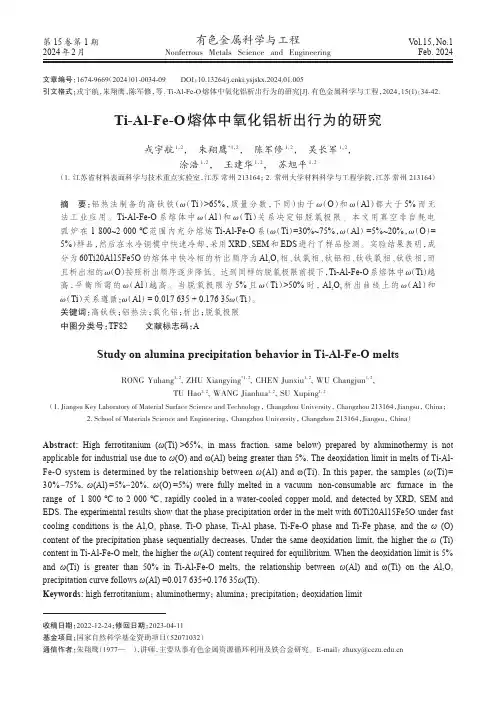
第15卷第1期2024年2月有色金属科学与工程Nonferrous Metals Science and EngineeringVol.15,No.1Feb. 2024Ti-Al-Fe-O 熔体中氧化铝析出行为的研究戎宇航1,2, 朱翔鹰*1,2, 陈军修1,2, 吴长军1,2,涂浩1,2, 王建华1,2, 苏旭平1,2(1.江苏省材料表面科学与技术重点实验室,江苏 常州 213164; 2.常州大学材料科学与工程学院,江苏 常州 213164)摘要:铝热法制备的高钛铁(ω(Ti )>65%,质量分数,下同)由于ω(O )和ω(Al )都大于5%而无法工业应用。
Ti-Al-Fe-O 系熔体中ω(Al )和ω(Ti )关系决定铝脱氧极限。
本文用真空非自耗电弧炉在1 800~2 000 ℃范围内充分熔炼Ti-Al-Fe-O 系(ω(Ti )=30%~75%,ω(Al ) =5%~20%,ω(O )=5%)样品,然后在水冷铜模中快速冷却,采用XRD 、SEM 和EDS 进行了样品检测。
实验结果表明,成分为60Ti20Al15Fe5O 的熔体中快冷相的析出顺序为Al 2O 3相、钛氧相、钛铝相、钛铁氧相、钛铁相,而且析出相的ω(O )按照析出顺序逐步降低。
达到同样的脱氧极限前提下,Ti-Al-Fe-O 系熔体中ω(Ti )越高,平衡所需的ω(Al )越高。
当脱氧极限为5%且ω(Ti )>50%时, Al 2O 3析出曲线上的ω(Al )和ω(Ti )关系遵循:ω(Al ) = 0.017 635 + 0.176 35ω(Ti )。
关键词:高钛铁;铝热法;氧化铝;析出;脱氧极限中图分类号:TF82 文献标志码:AStudy on alumina precipitation behavior in Ti-Al-Fe-O meltsRONG Yuhang 1, 2, ZHU Xiangying *1, 2, CHEN Junxiu 1, 2, WU Changjun 1, 2,TU Hao 1, 2, WANG Jianhua 1, 2, SU Xuping 1, 2(1. Jiangsu Key Laboratory of Material Surface Science and Technology , Changzhou University , Changzhou 213164,Jiangsu , China ;2. School of Materials Science and Engineering , Changzhou University , Changzhou 213164,Jiangsu , China )Abstract: High ferrotitanium (ω(Ti)>65%, in mass fraction, same below) prepared by aluminothermy is not applicable for industrial use due to ω(O) and ω(Al) being greater than 5%. The deoxidation limit in melts of Ti-Al-Fe-O system is determined by the relationship between ω(Al) and ω(Ti). In this paper, the samples (ω(Ti)=30%-75%, ω(Al)=5%-20%, ω(O)=5%) were fully melted in a vacuum non-consumable arc furnace in the range of 1 800 ℃ to 2 000 ℃, rapidly cooled in a water-cooled copper mold, and detected by XRD, SEM and EDS. The experimental results show that the phase precipitation order in the melt with 60Ti20Al15Fe5O under fast cooling conditions is the Al 2O 3 phase, Ti-O phase, Ti-Al phase, Ti-Fe-O phase and Ti-Fe phase, and the ω (O) content of the precipitation phase sequentially decreases. Under the same deoxidation limit, the higher the ω (Ti) content in Ti-Al-Fe-O melt, the higher the ω(Al) content required for equilibrium. When the deoxidation limit is 5% and ω(Ti) is greater than 50% in Ti-Al-Fe-O melts, the relationship between ω(Al) and ω(Ti) on the Al 2O 3 precipitation curve follows ω(Al) =0.017 635+0.176 35ω(Ti).Keywords: high ferrotitanium ; aluminothermy ; alumina ; precipitation ; deoxidation limit收稿日期:2022-12-24;修回日期:2023-04-11基金项目:国家自然科学基金资助项目(52071032)通信作者:朱翔鹰(1977— ),讲师,主要从事有色金属资源循环利用及铁合金研究。
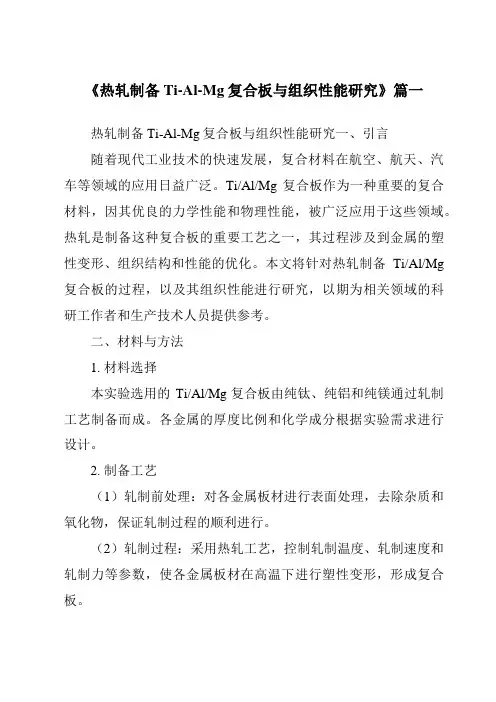
《热轧制备Ti-Al-Mg复合板与组织性能研究》篇一热轧制备Ti-Al-Mg复合板与组织性能研究一、引言随着现代工业技术的快速发展,复合材料在航空、航天、汽车等领域的应用日益广泛。
Ti/Al/Mg复合板作为一种重要的复合材料,因其优良的力学性能和物理性能,被广泛应用于这些领域。
热轧是制备这种复合板的重要工艺之一,其过程涉及到金属的塑性变形、组织结构和性能的优化。
本文将针对热轧制备Ti/Al/Mg 复合板的过程,以及其组织性能进行研究,以期为相关领域的科研工作者和生产技术人员提供参考。
二、材料与方法1. 材料选择本实验选用的Ti/Al/Mg复合板由纯钛、纯铝和纯镁通过轧制工艺制备而成。
各金属的厚度比例和化学成分根据实验需求进行设计。
2. 制备工艺(1)轧制前处理:对各金属板材进行表面处理,去除杂质和氧化物,保证轧制过程的顺利进行。
(2)轧制过程:采用热轧工艺,控制轧制温度、轧制速度和轧制力等参数,使各金属板材在高温下进行塑性变形,形成复合板。
(3)后处理:对轧制后的复合板进行退火处理,消除内应力,提高材料的力学性能。
3. 检测方法采用X射线衍射、金相显微镜、扫描电镜等手段对Ti/Al/Mg 复合板的组织结构进行观察和分析;采用拉伸试验、硬度测试等手段对其力学性能进行检测和评价。
三、结果与讨论1. 组织结构分析(1)X射线衍射结果表明,热轧制备的Ti/Al/Mg复合板中各金属相的晶格结构清晰可见,无明显相分离现象。
(2)金相显微镜和扫描电镜观察发现,热轧过程中各金属板材的塑性变形均匀,界面结合紧密,无明显孔洞和裂纹等缺陷。
2. 力学性能分析(1)拉伸试验结果表明,Ti/Al/Mg复合板具有较高的抗拉强度和延伸率,显示出良好的力学性能。
(2)硬度测试结果显示,复合板的硬度分布均匀,且高于单一金属的硬度。
这表明热轧过程中各金属的塑性变形和界面结合有利于提高材料的力学性能。
3. 影响因素分析(1)轧制温度对Ti/Al/Mg复合板的组织结构和性能具有重要影响。
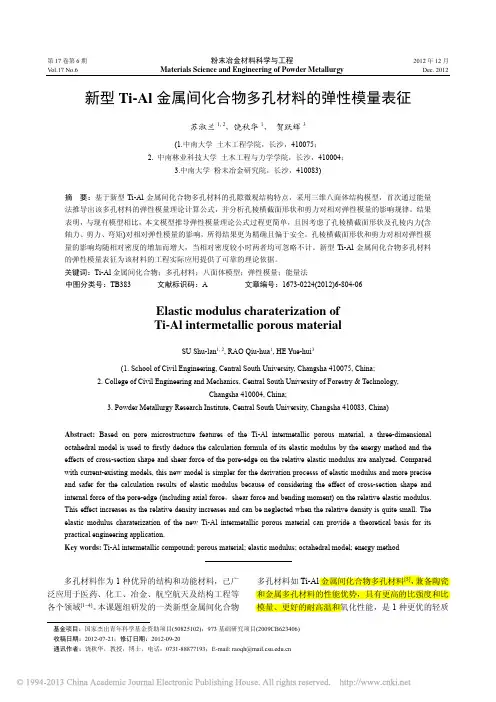
第17卷第6期粉末冶金材料科学与工程2012年12月V ol.17 No.6Materials Science and Engineering of Powder Metallurgy Dec. 2012新型Ti-Al金属间化合物多孔材料的弹性模量表征苏淑兰1, 2,饶秋华1,贺跃辉3(1.中南大学土木工程学院,长沙,410075;2. 中南林业科技大学土木工程与力学学院,长沙,410004;3.中南大学粉末冶金研究院,长沙,410083)摘要:基于新型Ti-Al金属间化合物多孔材料的孔隙微观结构特点,采用三维八面体结构模型,首次通过能量法推导出该多孔材料的弹性模量理论计算公式,并分析孔棱横截面形状和剪力对相对弹性模量的影响规律。
结果表明,与现有模型相比,本文模型推导弹性模量理论公式过程更简单,且因考虑了孔棱横截面形状及孔棱内力(含轴力、剪力、弯矩)对相对弹性模量的影响,所得结果更为精确且偏于安全。
孔棱横截面形状和剪力对相对弹性模量的影响均随相对密度的增加而增大,当相对密度较小时两者均可忽略不计。
新型Ti-Al金属间化合物多孔材料的弹性模量表征为该材料的工程实际应用提供了可靠的理论依据。
关键词:Ti-Al金属间化合物;多孔材料;八面体模型;弹性模量;能量法中图分类号:TB383文献标识码:A 文章编号:1673-0224(2012)6-804-06Elastic modulus charaterization ofTi-Al intermetallic porous materialSU Shu-lan1, 2, RAO Qiu-hua1, HE Yue-hui3(1. School of Civil Engineering, Central South University, Changsha 410075, China;2. College of Civil Engineering and Mechanics, Central South University of Forestry & Technology,Changsha 410004, China;3. Powder Metallurgy Research Institute, Central South University, Changsha 410083, China)Abstract: Based on pore microstructure features of the Ti-Al intermetallic porous material, a three-dimensional octahedral model is used to firstly deduce the calculation formula of its elastic modulus by the energy method and the effects of cross-section shape and shear force of the pore-edge on the relative elastic modulus are analyzed. Compared with current-existing models, this new model is simpler for the derivation processs of elastic modulus and more precise and safer for the calculation results of elastic modulus because of considering the effect of cross-section shape and internal force of the pore-edge (including axial force,shear force and bending moment) on the relative elastic modulus.This effect increases as the relative density increases and can be neglected when the relative density is quite small. The elastic modulus charaterization of the new Ti-Al intermetallic porous material can provide a theoretical basis for its practical engineering application.Key words: Ti-Al intermetallic compound; porous material; elastic modulus; octahedral model; energy method多孔材料作为1种优异的结构和功能材料,已广泛应用于医药、化工、冶金、航空航天及结构工程等各个领域[1−4]。